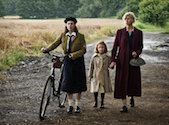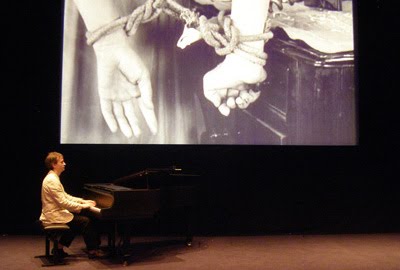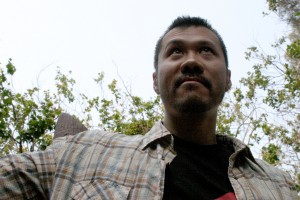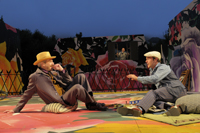 I was at the Jewish Film Festival‘s opening night over the weekend. The event prompted me to think about a few ways to make the event a night to remember versus one that is instantly forgettable. Here are my thoughts:
I was at the Jewish Film Festival‘s opening night over the weekend. The event prompted me to think about a few ways to make the event a night to remember versus one that is instantly forgettable. Here are my thoughts:
1. Start with a film that possesses a strong storyline and characters. It should ensnare the mind and the heart in equal part. Or if it can only do one of these things, the heart should come first. Sounds obvious, I know. But a heady film or something too experimental won’t jibe with the opening night crowd, which most likely has a large quotient of party people, staff from various embassies and corporate sponsors. The JFF hit exactly the right note with Ludi Boeken’s Saviors in the Night, a gripping but thankfully not cliche-ridden Holocaust story set in Germany (screenshot from movie pictured above).
2. Keep opening remarks short, or better still, obliterate them completely. The JFF’s speeches went on for way too long on Saturday evening — around half an hour at least, it seemed. No one around me seemed to be listening. The festival’s organizer’s should take note.
3. If you’re going to have a panel discussion after the opening night movie (and I question whether this is a good idea, especially if the audience has also had to sit through verbose opening speeches) make sure you have the A-Team of panel members. The JFF pulled out all the stops with a diverse group including the 90-something year old woman on whose life story Saviors in the Night is based.
4. Throw a really good after-party. The JFF again struck gold with a bash at the Swedish American Hall which featured really tasty Jewish cuisine-ish inspired food (I loved the egg salad on rye, the whitefish ceviche and the bread pudding) and peppy gypsy-ish music by the local old-school jazz outfit Gaucho. People danced and ate and drank and talked well into the night. The atmosphere was surprisingly hip for a film festival and there was a great buzz in the building.

 It’s not surprising to hear that major recording labels like Decca think they can make a lot of money from the chant music of cloistered nuns, as the
It’s not surprising to hear that major recording labels like Decca think they can make a lot of money from the chant music of cloistered nuns, as the  The
The  Since the media industry is what optimists call “going through a period of transition” and pessimists call “in the shitter,” arts journalists have increasingly found themselves losing their jobs, and, whether on staff or freelance, working harder for less money. Nothing about this is new and it seems unlikely as far as I can tell, that things will change much for the next five to ten years.
Since the media industry is what optimists call “going through a period of transition” and pessimists call “in the shitter,” arts journalists have increasingly found themselves losing their jobs, and, whether on staff or freelance, working harder for less money. Nothing about this is new and it seems unlikely as far as I can tell, that things will change much for the next five to ten years. Someone from an art museum in San Francisco contacted me about doing a story about the fact that the museum has two campuses. Perhaps I’m missing something but multi-campus arts organizations don’t seem like a particularly unique thing. I can think of several such institutions in the Bay Area right off the top of my head — The Fine Arts Museums (the de Young museum and the Legion of Honor), Intersection for the Arts (which now has a new wing in downtown San Francisco in addition to its home-base in the Mission ) and The Marsh (which has a campus in The Mission and in downtown Berkeley).
Someone from an art museum in San Francisco contacted me about doing a story about the fact that the museum has two campuses. Perhaps I’m missing something but multi-campus arts organizations don’t seem like a particularly unique thing. I can think of several such institutions in the Bay Area right off the top of my head — The Fine Arts Museums (the de Young museum and the Legion of Honor), Intersection for the Arts (which now has a new wing in downtown San Francisco in addition to its home-base in the Mission ) and The Marsh (which has a campus in The Mission and in downtown Berkeley). Saturday was a big day of film music for me. I spent the daytime hours preparing for and moderating a panel for the
Saturday was a big day of film music for me. I spent the daytime hours preparing for and moderating a panel for the  I have a great deal of admiration for Alan So (pictured), the energetic artistic director / programmer behind the eclectic San Francisco
I have a great deal of admiration for Alan So (pictured), the energetic artistic director / programmer behind the eclectic San Francisco  Since
Since  I love those spiraling evenings where you hop from one amazing arts event to another. Last night was epic. A brief summary:
I love those spiraling evenings where you hop from one amazing arts event to another. Last night was epic. A brief summary: This morning, I was interviewed by a couple of marketing consultants as part of a project aimed at helping them pull together a branding and messaging strategy for a local performing arts organization.
This morning, I was interviewed by a couple of marketing consultants as part of a project aimed at helping them pull together a branding and messaging strategy for a local performing arts organization. No summer in the Bay Area is complete without a trip to Orinda to experience a production and picnic at the
No summer in the Bay Area is complete without a trip to Orinda to experience a production and picnic at the